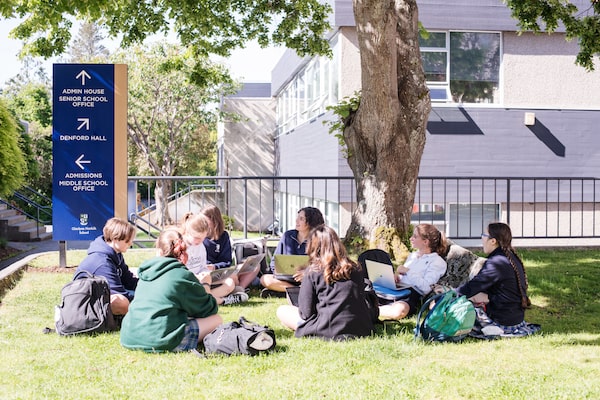
Glenlyon Norfolk in Victoria was able to stay open through the entire pandemic by moving classes outside and keeping windows open, thanks to the area's mild climate.
Tracy Vaillancourt’s eldest daughter attended public school until postsecondary, but when Ms. Vaillancourt experienced a health issue in 2019, she decided to move her younger daughter to a private institution next to her workplace.
“People choose [where to send their kids to school] for different reasons; mine was about wanting to commute together,” says Ms. Vaillancourt, who works as a professor at the University of Ottawa’s faculty of education. “Now, her school is right beside the university.”
Ms. Vaillancourt, however, says that decision proved much more significant once the pandemic began. “I have a lot of friends who have children of the same age who were in public schools, and our experiences were so different,” she says.
For example, while most public institutions her friends’ children attended had paused standardized testing during the pandemic, her daughter’s International Baccalaureate (IB) school maintained them. Ms. Vaillancourt adds that the school facilitated more in-person learning, and provided more individual support, thanks to a low ratio of students to teachers.
Although many Canadian provinces halted standardized tests, making it more difficult to measure changes, results from other jurisdictions globally show a significant decline in academic performance during the pandemic. A recent report published by the National Assessment of Educational Progress, for example, found reading scores among nine-year-olds in the United States declined by the largest margin in more than 30 years. Math scores, meanwhile, declined for the first time since the agency began tracking student achievement in the 1970s.
Ms. Vaillancourt, who is also a fellow of the Royal Society of Canada where she leads research into the effects of the pandemic on students, says Canada’s public and private institutions have historically delivered similar academic results. “This was the first time where I think there was a real advantage going to a private school,” she adds.
Due to their funding structures, private institutions were more likely to have resources in place prior to the outbreak that proved vital to maintaining academic achievement during the disruption.
For example, during the pandemic Appleby College in Oakville, Ont., had to follow provincially mandated health and safety standards, and regularly transitioned from in-person to remote to hybrid learning. Those transitions, however, were relatively smooth because Appleby had previously established a digital learning program and moved quickly to install video-conferencing technology in its classrooms.
“Did our core academic program change? I really don’t think so; we just adapted what we do to different modes,” says Sarah Morrison, the assistant head of academics for Appleby, a private institution of about 790 students in Grades 7 through 12.
“We took opportunities to connect with guest speakers from across the country who were also at home and were willing to give us their time to enhance our digital programming,” explains Ms. Morrison, adding that the school will continue to leverage the technology to connect students with guest speakers in the future.
While the institution maintained its educational standards, Ms. Morrison says Appleby is now welcoming new students who have had a wide range of pandemic learning experiences. “They might need a little extra one-on-one time,” she explains.
To prepare, the institution has added academic support into its daily schedule to avoid cutting into after-school hours, which Ms. Morrison hopes students will dedicate to its many extracurricular programs. Appleby also provides student-led support programs, such as peer tutoring, a guidance department, student success centre, a learning hub for one-on-one coaching, and more.
Thanks to these additional layers of support, some private intuitions in Canada actually saw academic achievement increase during the pandemic.
“In our [International Baccalaureate] Diploma exam results for Grade 12 students, the last two years were our two strongest in the last 10,” says Cole Carlson, the deputy head of school at Glenlyon Norfolk, a private institution in Victoria. “Provincially, we have Foundation Skills Assessments, and those are done in Grade 4 and Grade 7 – those are benchmarked against all the schools in the province – and our Grade 7 [scores] were the highest they had ever been.”
Mr. Carlson adds that the institution was one of a few in the country that remained open through the entire pandemic, though it did have to take precautions, such as reducing class sizes and limiting the movements of teachers in classrooms. Glenlyon Norfolk also increased its cleaning protocols and hygiene standards and was able to keep windows open year round – even moving some classes outdoors – thanks to Victoria’s mild climate. Mr. Carlson suggests academic achievement may have improved during the pandemic because there were fewer distractions.
Glenlyon Norfolk’s success has also resulted in higher demand. This year, enrolment increased from about 665 to 800 students, including many international students. That means that students are arriving with a wide range of pandemic learning experiences.
“We have a pretty intensive boarding program in the first few weeks of school, and our faculty and staff are all watching for early warning signs for academic needs, for social and emotional needs, or other potential interventions,” he says. “That’s on everybody’s radar.”
Mr. Carlson says once a need is identified, the school takes a trauma informed approach and works with a range of “community members” – including parents, teachers, administration staff, counsellors and academic advisers, among others – to develop a plan for getting students back on track.
One of the key messages Mr. Carlson tries to communicate with students is that, despite the challenges of the pandemic period, they have an opportunity to emerge even more resilient and better prepared for their futures.
“There is a silver lining there that kids can take away,” he says. “We probably overcame the biggest challenge in a generation, and I would say we’re stronger for it.”